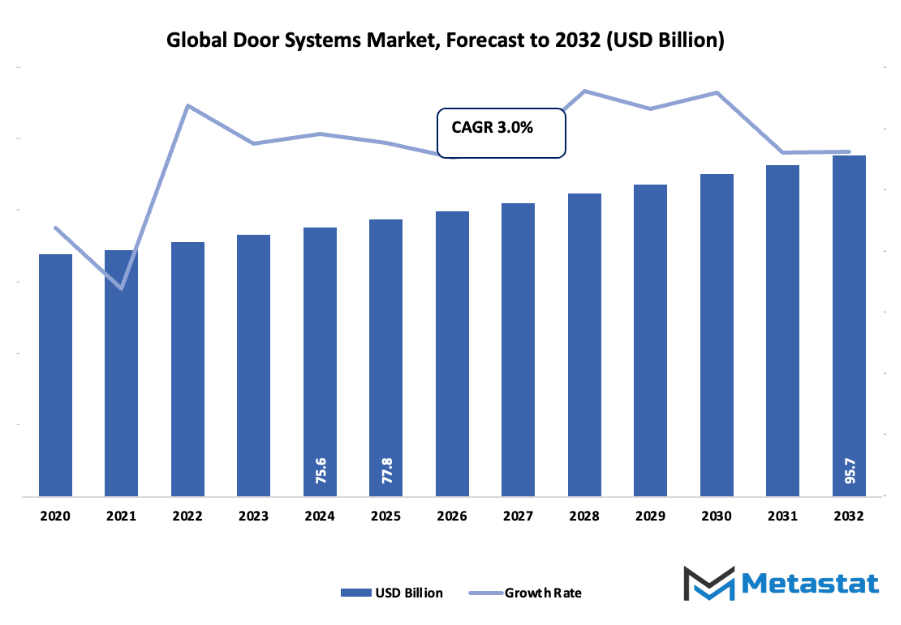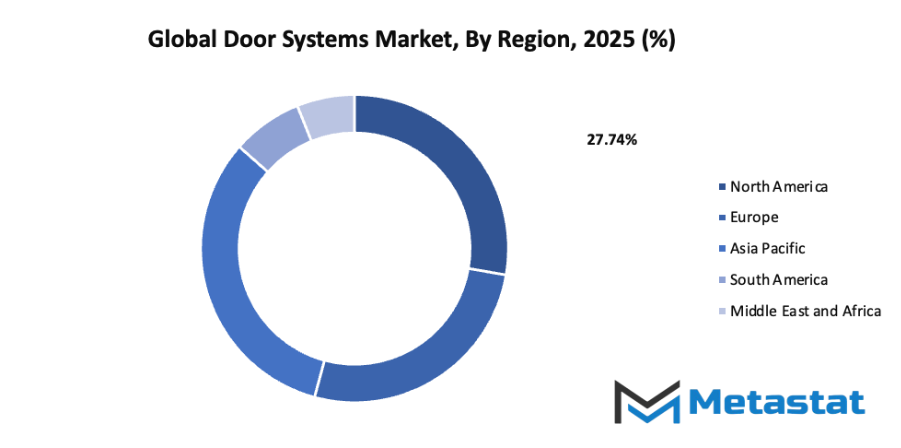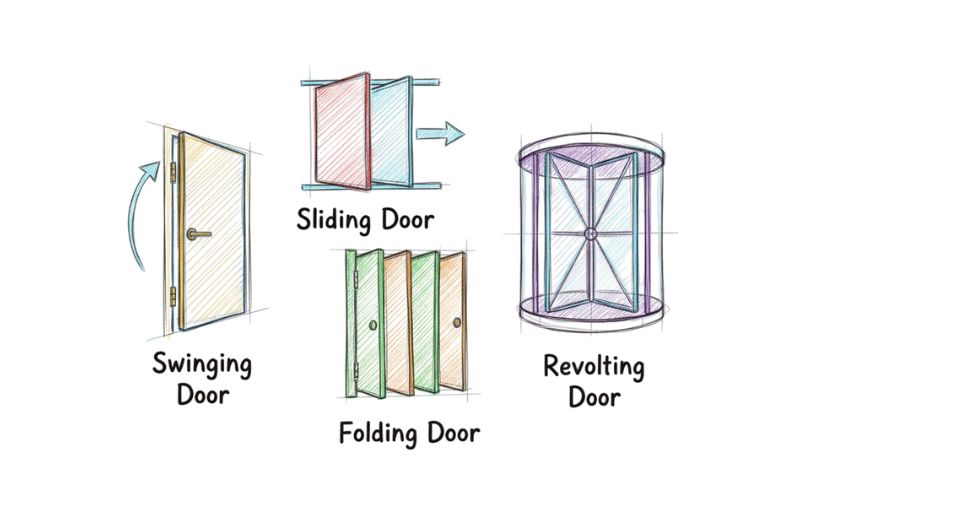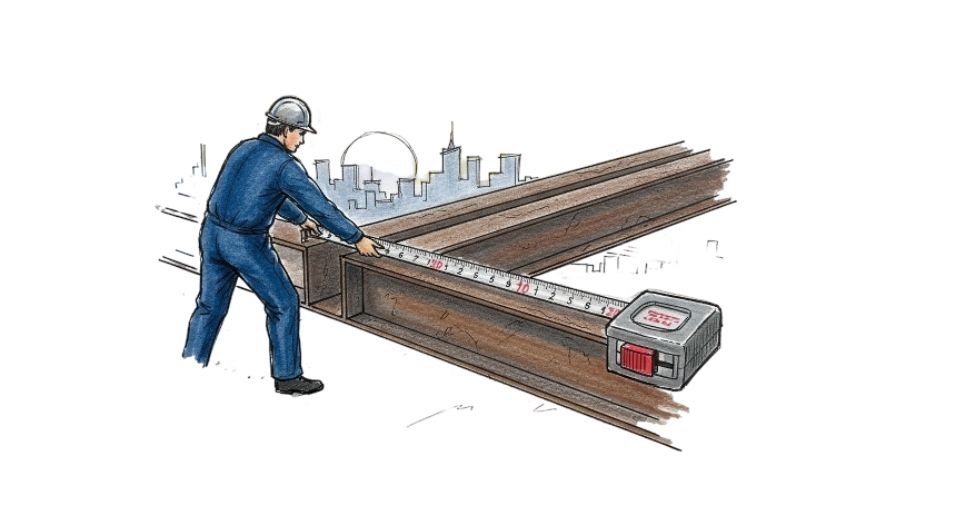Global Door Systems Market- Comprehensive Data-Driven Market Analysis & Strategic Outlook
The global door systems market has evolved to be a vibrant part of the building and architectural business shaped by centuries of innovation, transition, and artisanship. It began in early civilization days when doors were barely anything more than a stone or wood barrier formed for protection and safety. Over time, societies began to view doors not only as functional objects but also as expressions of culture and aesthetics. The industrial revolution marked a critical juncture in the global door systems market, where mechanization made mass production and standardization possible. Steel and glass became the normative materials, transforming once-handmade wooden panels into engineered systems for durability and precision.
- Global door systems market valued at approximately USD 77.8 Billion in 2025, growing at a CAGR of around 3.0% through 2032, with potential to exceed USD 95.7 Billion.
- Wood account for nearly 27.0% market share, driving innovation and expanding applications through intense research.
- Key trends driving growth: Rising demand for energy-efficient and smart door solutions
- Opportunities include: Growing adoption of automated and IoT-enabled door systems
- Key insight: The market is set to grow exponentially in value over the next decade, highlighting significant growth opportunities.
- As urbanization fueled growth in the 20th century, the demand for efficient and effective door solutions grew.

Factories, industrial buildings, and apartments needed systems that could cope with heavy use without sacrificing aesthetics. Automatic revolving and sliding doors became a reality in this period and brought a complete transformation to the way humans reacted to entrances. The late 20th century was marked by yet another milestone with the integration of electronic access controls, bringing mechanical engineering and digital technology together. Convenience and security were brought together, driving the market towards a new era of intelligent systems. Environmental awareness in the last decades has played a critical role in reshaping manufacturing techniques and the use of materials. The doors produced today are designed in accordance with energy saving and sustainability, using insulated materials and eco-friendly components.
Consumer demands have shifted towards products with design elegance side by side due to performance stability. Concurrently, the progress in automation and home intelligence is pressurizing producers to innovate beyond the present possibilities. Integrated systems that are voice-controlled or networked into building management systems will become the new standard soon, reflecting growing demand for customization and convenience. In the years to come, the global door systems market will continue to evolve with greater innovation and stronger regulation on safety and energy requirements. A craft that began modestly will exist as a merging of design, engineering, and technology a lasting symbol of how function and creativity can evolve hand in hand.
Market Segments
The global door systems market is mainly classified based on Material, Mechanism, Technology, Application.
By Material is further segmented into:
- Wood: Wood segment in global door systems market will continue to have stable demand due to its heritage beauty and natural look. It provides good insulation and design versatility for both new and old structures. Treated wood's long life further adds to its escalating use in residential building.
- Metal: The metal segment in the global door systems market will grow because it is safe, secure, and long-lasting. It is generally used in commercial and industrial settings where durability and safety are priorities. Aluminum and steel application also promotes green building approaches and garner more interest from all industries.
- Glass: The glass segment in the global door systems market will increase as there is a growing demand for clear and elegant appearance. It allows for natural light to enter and gives a sense of modernity to rooms. The tempered and strengthened glass doors also ensure security without compromising the open and sophisticated atmosphere in homes and non-residential structures.
- Composite: The composite part of the global door systems market will be on the rise as they bring together numerous materials to create strength, insulation, and design flexibility. The doors are warp-resistant, rust-resistant, and corrosion-resistant and hence reliable in different climates. Low energy consumption and low maintenance nature also raise their demand.
- Others: They compete with other materials available in the global door systems market, such as fiberglass, PVC, and uPVC, that offer many design and performance capabilities. They are cost-efficient and water-resistant, which is an advantage for using them in interior and exterior uses. Their lightweight also allows for easy and fast installation.
By Mechanism the market is divided into:
- Swinging: The swinging segment in the global door systems market will remain dominant due to its simple design and wide usage in homes and offices. It offers ease of installation and repair while fitting different architectural styles. The affordability and functionality of swinging doors keep them widely preferred worldwide.
- Sliding: The sliding segment in the global door systems market will see strong growth driven by space-saving needs and modern interiors. These doors are ideal for compact areas and add a sleek appearance to homes and workplaces. Smooth operation and enhanced aesthetics contribute to their increasing popularity among buyers.
- Folding: The folding segment in the global door systems market will gain attention for its ability to open large spaces efficiently. It is often used in patios, halls, and commercial areas to connect indoor and outdoor environments. Folding doors also support energy efficiency by improving natural ventilation and light flow.
- Revolving: The revolving segment in the global door systems market will grow steadily due to its application in commercial and public buildings. It helps maintain indoor temperature by reducing air exchange, improving energy efficiency. The segment also enhances security and traffic flow, making it suitable for high-traffic urban spaces.
- Others: Other mechanisms in the global door systems market include overhead, pivot, and telescopic types. These systems meet diverse architectural and functional needs, providing tailored solutions for specific environments. The adaptability and innovative operation of these doors make them appealing in both industrial and custom-designed projects.
By Technology the market is further divided into:
- Manual: The manual segment in the global door systems market will retain steady use due to its cost-effectiveness and ease of operation. It requires no power source and remains suitable for low-traffic areas. Manual doors are reliable and long-lasting, making them practical for both household and small business applications.
- Automatic: The automatic segment in the global door systems market will expand rapidly with growing interest in smart infrastructure. It offers convenience and accessibility, especially in commercial and healthcare facilities. Features such as motion sensors and remote operation increase efficiency and user comfort, promoting wider adoption globally.
- Access Control: The access control segment in the global door systems market will see rising demand due to heightened security concerns. It integrates technology like biometric scanners and keycard systems, improving safety in both residential and business environments. This segment supports smart building trends and enhances overall operational management.
By Application the global door systems market is divided as:
- Residential: The residential segment in the global door systems market will grow with ongoing housing developments and home renovation projects. The demand for stylish, energy-efficient, and secure doors continues to rise. Improved material choices and custom designs further attract homeowners seeking durability and visual appeal.
- Non-Residential: The non-residential segment in the global door systems market will experience notable expansion due to growth in commercial, industrial, and institutional buildings. These doors focus on durability, access control, and safety standards. Enhanced automation and material innovation continue to drive adoption across large-scale infrastructure developments.
|
Forecast Period |
2025-2032 |
|
Market Size in 2025 |
$77.8 Billion |
|
Market Size by 2032 |
$95.7 Billion |
|
Growth Rate from 2025 to 2032 |
3.0% |
|
Base Year |
2024 |
|
Regions Covered |
North America, Europe, Asia-Pacific, South America, Middle East & Africa |
By Region:
- Based on geography, the global door systems market is divided into North America, Europe, Asia-Pacific, South America, and the Middle East & Africa.
- North America is further divided into the U.S., Canada, and Mexico, whereas Europe consists of the UK, Germany, France, Italy, and the Rest of Europe.
- Asia-Pacific is segmented into India, China, Japan, South Korea, and the Rest of Asia-Pacific.
- The South America region includes Brazil, Argentina, and the Rest of South America, while the Middle East & Africa is categorized into GCC Countries, Egypt, South Africa, and the Rest of the Middle East & Africa.

Growth Drivers
- Rising demand for energy-efficient and smart door solutions: The global door systems market will continue to expand due to a growing preference for energy-efficient and smart door solutions. Many industries and commercial facilities are focusing on reducing energy use and improving building security. Smart door systems with sensors and automation offer convenience, safety, and long-term energy savings.
- Rapid urbanization and increasing infrastructure development: The global door systems market will benefit from the steady pace of urban growth and infrastructure expansion. The construction of new residential, commercial, and industrial buildings will increase the need for advanced door systems. Modern cities will require secure, durable, and technologically equipped door systems to support development.
Challenges and Opportunities
- High installation and maintenance costs: The global door systems market faces challenges due to high installation and maintenance expenses. Many smart and automated door systems require complex components and regular upkeep. These costs may limit adoption among smaller businesses or residential users, affecting market expansion in some regions.
- Stringent regulatory and safety standards: The global door systems market must meet strict safety and regulatory requirements. Compliance with building codes, fire safety laws, and international standards can be time-consuming and costly. These regulations ensure quality and safety but can also slow product launches and increase production costs.
Opportunities
- Growing adoption of automated and IoT-enabled door systems: The global door systems market will gain new opportunities through the rising use of automated and IoT-enabled doors. Integration with smart technologies allows improved access control, monitoring, and energy management. Demand for advanced systems in commercial spaces, airports, and healthcare facilities will drive future growth.
Competitive Landscape & Strategic Insights
The global door systems market reflects a dynamic landscape shaped by both long-standing international manufacturers and a growing number of regional innovators. As demand for security, energy efficiency, and aesthetic design continues to rise, this industry is expected to experience steady progress driven by technological integration and changing architectural preferences. With expanding construction activities across residential, commercial, and industrial sectors, the need for reliable and adaptable door systems has never been greater.
The industry is a mix of both international industry leaders and emerging regional competitors. Important competitors include Assa Abloy, Dorma Kaba, Allegion Plc, Masonite, Anderson Corporation, Simpson Door Company, Jeld Wen Inc, PGT, Fancy Doors and Mouldings, Cornerstone Corporation, ARCAT, La Cantina Doors, Pella Corporation, Atrium, Marvin, OCM Industrial Doors, Masonite International Corporation, Lowe’s Companies, Inc., JELD-WEN Holding, Inc., and HaciendaRustica in the global door systems market. These companies continue to strengthen their positions through product innovation, strategic partnerships, and an increased focus on sustainability. Many of them are integrating advanced automation and smart technologies, offering products that provide convenience, safety, and energy management through intelligent locking systems and digital controls.
Looking ahead, technological development will play a central role in shaping the future of door systems. The rise of smart homes and connected infrastructure will encourage greater use of automated doors equipped with sensors and wireless connectivity. The growing trend toward green construction will also promote doors made from recycled or eco-friendly materials, balancing performance with environmental responsibility. Furthermore, digital platforms will make customization more accessible, allowing customers to design doors that suit specific architectural and functional needs.
Market competition will likely intensify as regional manufacturers adopt advanced production techniques to compete with established brands. This will lead to broader product diversity and more competitive pricing. As emerging economies continue to urbanize, their growing middle-class populations will increase demand for modern housing solutions, thereby expanding the customer base for door systems. The industry’s progress will also depend on regulatory standards related to building safety and energy efficiency, pushing companies to comply with stricter requirements and improve their product quality.
Market size is forecast to rise from USD 77.8 Billion in 2025 to over USD 95.7 Billion by 2032. Door Systems will maintain dominance but face growing competition from emerging formats.
Future growth in the global door systems market will be closely tied to innovation and sustainability. Manufacturers that focus on combining technology with design flexibility will be better positioned to meet evolving customer expectations. With continuous investment in research and development, the door systems industry is set to move toward a future where security, design, and sustainability come together to create smarter, more efficient spaces for both residential and commercial environments.
Report Coverage
This research report categorizes the global door systems market based on various segments and regions, forecasts revenue growth, and analyzes trends in each submarket. The report analyses the key growth drivers, opportunities, and challenges influencing the global door systems market. Recent market developments and competitive strategies such as expansion, type launch, development, partnership, merger, and acquisition have been included to draw the competitive landscape in the market. The report strategically identifies and profiles the key market players and analyses their core competencies in each sub-segment of the global door systems market.
Door Systems Market Key Segments:
By Material
- Wood
- Metal
- Glass
- Composite
- Others
By Mechanism
- Swinging
- Sliding
- Folding
- Revolving
- Others
By Technology
- Manual
- Automatic
- Access Control
By Application
- Residential
- Non-Residential
Key Global Door Systems Industry Players
- Assa Abloy
- Dorma Kaba
- Allegion Plc
- Masonite
- Anderson Corporation
- Simpson Door Company
- Jeld Wen Inc
- PGT
- Fancy Doors and Mouldings
- Cornerstone Corporation
- ARCAT
- La Cantina Doors
- Pella Corporation
- Atrium
- Marvin
- OCM Industrial Doors
- Masonite International Corporation
- Lowe’s Companies, Inc.
- JELD-WEN Holding, Inc.
- HaciendaRustica
WHAT REPORT PROVIDES
- Full in-depth analysis of the parent Industry
- Important changes in market and its dynamics
- Segmentation details of the market
- Former, on-going, and projected market analysis in terms of volume and value
- Assessment of niche industry developments
- Market share analysis
- Key strategies of major players
- Emerging segments and regional growth potential








 US: +1 3023308252
US: +1 3023308252






